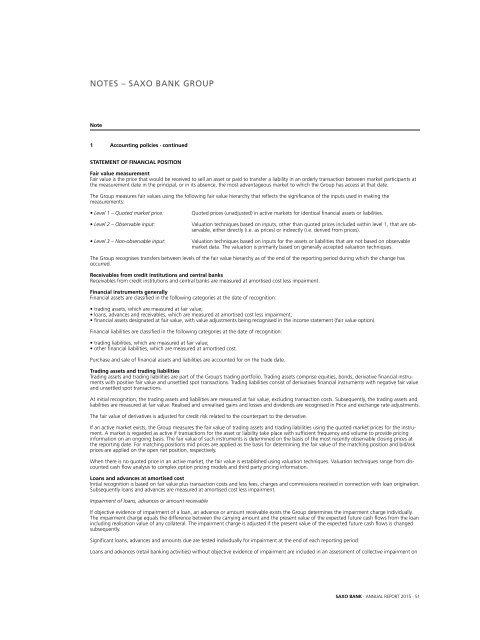saxo-bank-annual-report-2015
saxo-bank-annual-report-2015
saxo-bank-annual-report-2015
You also want an ePaper? Increase the reach of your titles
YUMPU automatically turns print PDFs into web optimized ePapers that Google loves.
NOTES – SAXO BANK GROUP<br />
Note<br />
1 Accounting policies · continued<br />
STATEMENT OF FINANCIAL POSITION<br />
Fair value measurement<br />
Fair value is the price that would be received to sell an asset or paid to transfer a liability in an orderly transaction between market participants at<br />
the measurement date in the principal, or in its absence, the most advantageous market to which the Group has access at that date.<br />
The Group measures fair values using the following fair value hierarchy that reflects the significance of the inputs used in making the<br />
measurements:<br />
• Level 1 – Quoted market price:<br />
• Level 2 – Observable input:<br />
• Level 3 – Non-observable input:<br />
Quoted prices (unadjusted) in active markets for identical financial assets or liabilities.<br />
Valuation techniques based on inputs, other than quoted prices included within level 1, that are observable,<br />
either directly (i.e. as prices) or indirectly (i.e. derived from prices).<br />
Valuation techniques based on inputs for the assets or liabilities that are not based on observable<br />
market data. The valuation is primarily based on generally accepted valuation techniques.<br />
The Group recognises transfers between levels of the fair value hierarchy as of the end of the <strong>report</strong>ing period during which the change has<br />
occurred.<br />
Receivables from credit institutions and central <strong>bank</strong>s<br />
Receivables from credit institutions and central <strong>bank</strong>s are measured at amortised cost less impairment.<br />
Financial instruments generally<br />
Financial assets are classified in the following categories at the date of recognition:<br />
• trading assets, which are measured at fair value;<br />
• loans, advances and receivables, which are measured at amortised cost less impairment;<br />
• financial assets designated at fair value, with value adjustments being recognised in the income statement (fair value option).<br />
Financial liabilities are classified in the following categories at the date of recognition:<br />
• trading liabilities, which are measured at fair value;<br />
• other financial liabilities, which are measured at amortised cost.<br />
Purchase and sale of financial assets and liabilities are accounted for on the trade date.<br />
Trading assets and trading liabilities<br />
Trading assets and trading liabilities are part of the Group’s trading portfolio. Trading assets comprise equities, bonds, derivative financial instruments<br />
with positive fair value and unsettled spot transactions. Trading liabilities consist of derivatives financial instruments with negative fair value<br />
and unsettled spot transactions.<br />
At initial recognition, the trading assets and liabilities are measured at fair value, excluding transaction costs. Subsequently, the trading assets and<br />
liabilities are measured at fair value. Realised and unrealised gains and losses and dividends are recognised in Price and exchange rate adjustments.<br />
The fair value of derivatives is adjusted for credit risk related to the counterpart to the derivative.<br />
If an active market exists, the Group measures the fair value of trading assets and trading liabilities using the quoted market prices for the instrument.<br />
A market is regarded as active if transactions for the asset or liability take place with sufficient frequency and volume to provide pricing<br />
information on an ongoing basis. The fair value of such instruments is determined on the basis of the most recently observable closing prices at<br />
the <strong>report</strong>ing date. For matching positions mid prices are applied as the basis for determining the fair value of the matching position and bid/ask<br />
prices are applied on the open net position, respectively.<br />
When there is no quoted price in an active market, the fair value is established using valuation techniques. Valuation techniques range from discounted<br />
cash flow analysis to complex option pricing models and third party pricing information.<br />
Loans and advances at amortised cost<br />
Initial recognition is based on fair value plus transaction costs and less fees, charges and commissions received in connection with loan origination.<br />
Subsequently loans and advances are measured at amortised cost less impairment.<br />
Impairment of loans, advances or amount receivable<br />
If objective evidence of impairment of a loan, an advance or amount receivable exists the Group determines the impairment charge individually.<br />
The impairment charge equals the difference between the carrying amount and the present value of the expected future cash flows from the loan<br />
including realisation value of any collateral. The impairment charge is adjusted if the present value of the expected future cash flows is changed<br />
subsequently.<br />
Significant loans, advances and amounts due are tested individually for impairment at the end of each <strong>report</strong>ing period.<br />
Loans and advances (retail <strong>bank</strong>ing activities) without objective evidence of impairment are included in an assessment of collective impairment on<br />
SAXO BANK · ANNUAL REPORT <strong>2015</strong> · 51


